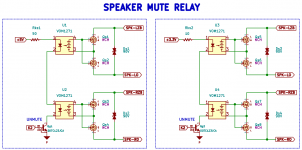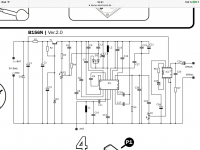I have, what should be, the full BOM for the xmas amp shown here
Xmas Amp - Dibya's TDA7293 by Jhofland
brand new in sealed bags from Mouser. Enough parts to populate both boards. The inductors on the list may or may not work. They were mentioned in a post in the thread but you may need to wind your own per the instructions in the thread. You will also need insulator and shoulder washer for mounting the chips to heatsink (and heatsinks)
The 2 PCBs come for free with the parts.
SOLD
here's the parts list,
please verify it is all that is needed and that I didn't miss anything:
Mouser #: 810-FG28C0G1H470JNT0
Mfr. #: FG28C0G1H470JNT00
Desc.: Multilayer Ceramic Capacitors MLCC - Leaded Multilayer Ceramic Capacitors MLCC - Leaded RAD 50V 47pF C0G 5% LS:5mm
C28 2)
Mouser #: 505-FKP2G002201D00JS
Mfr. #: FKP2G002201D00JSSD
Desc.: Film Capacitors Film Capacitors FKP 2 220 pF 400 VDC 4.5x6x7.2 PCM5
C10 2)
Mouser #: 505-MKS2D031001A00JI
Mfr. #: MKS2D031001A00JI00
Desc.: Film Capacitors Film Capacitors 0.1 uF 100 VDC 5%
C3, C4, C17, C18 8)
Mouser #: 505-MKP4D041005D00KS
Mfr. #: MKP4D041005D00KSSD
Desc.: Film Capacitors Film Capacitors 1.0 uF 100 VDC 10%
C101, C127 4)
Mouser #: 667-ECW-FD2W105J
Mfr. #: ECW-FD2W105J
Desc.: Film Capacitors Film Capacitors 450VDC 1.0uF 5% MPP L/S=15mm
C1, C27 4)
Mouser #: 810-FG28X5R1H105KRT0
Mfr. #: FG28X5R1H105KRT00
Desc.: Multilayer Ceramic Capacitors MLCC - Leaded Multilayer Ceramic Capacitors MLCC - Leaded RAD 50V 1uF X5R 10% LS:5mm
C12, C13, C14, C15, C 12)
Mouser #: 505-MKP4F044706F00JS
Mfr. #: MKP4F044706F00JSSD
Desc.: Film Capacitors Film Capacitors 4.7uF 250 Volts 5%
C201 2)
Mouser #: 667-ECA-1JHG100
Mfr. #: ECA-1JHG100
Desc.: Aluminum Electrolytic Capacitors - Radial Leaded Aluminum Electrolytic Capacitors - Radial Leaded 10uF 63V
C7, C8, C19, C20, C21 16)
Mouser #: 647-UES1C101MPM
Mfr. #: UES1C101MPM
Desc.: Aluminum Electrolytic Capacitors - Radial Leaded Aluminum Electrolytic Capacitors - Radial Leaded 16volts 100uF 85c 10x12.5 5LS
C2 2)
Mouser #: 647-UKZ1H101MHM
Mfr. #: UKZ1H101MHM
Desc.: Aluminum Electrolytic Capacitors - Radial Leaded Aluminum Electrolytic Capacitors - Radial Leaded 50volts 100uF 85C 12.5X20 5LS
C16 2)
Mouser #: 667-EEU-FC1J221S
Mfr. #: EEU-FC1J221S
Desc.: Aluminum Electrolytic Capacitors - Radial Leaded Aluminum Electrolytic Capacitors - Radial Leaded 220uF 63V
C5, C6, C9, C11 8)
Mouser #: 78-1N5059-TR
Mfr. #: 1N5059TR
Desc.: Rectifiers Rectifiers DIODE 2A 200V
D1, D2 4)
Mouser #: 78-1N4148
Mfr. #: 1N4148TR
Desc.: Diodes - General Purpose, Power, Switching Diodes - General Purpose, Power, Switching 100V Io/150mA T/R
D3, D8, D9 6)
Mouser #: 621-1N4004
Mfr. #: 1N4004-T
Desc.: Rectifiers Rectifiers Vr/400V Io/1A T/R
D4, D5, D6, D7 8)
Mouser #: 538-39-29-9063
Mfr. #: 39-29-9063
Desc.: Headers & Wire Housings Headers & Wire Housings 6 CRT VERT HEADER
J1 2)
Mouser #: 538-22-23-2021
Mfr. #: 22-23-2021
Desc.: Headers & Wire Housings Headers & Wire Housings VERT PCB HDR 2P TIN FRICTION LOCK
J2 2)
Mouser #: 538-39-29-9043
Mfr. #: 39-29-9043
Desc.: Headers & Wire Housings Headers & Wire Housings 4 CKT VERT HEADER
J3 2)
Mouser #: 994-SER1590-102MLB
Mfr. #: SER1590-102MLB
Desc.: Fixed Inductors Fixed Inductors 1uH Shld 20% 27A 940mOhms
L1 2)
Mouser #: 594-5083NW2R200JA100
Mfr. #: PR02000202208JA100
Desc.: Metal Film Resistors - Through Hole Metal Film Resistors - Through Hole 2watt 2.2ohms 5%
R8 2)
Mouser #: 594-5083NW10R00J
Mfr. #: PR02000201009JR500
Desc.: Metal Film Resistors - Through Hole Metal Film Resistors - Through Hole 2watts 10ohms 5%
R5 4)
Mouser #: 660-MF1/4DC2150F
Mfr. #: MF1/4DC2150F
Desc.: Metal Film Resistors - Through Hole Metal Film Resistors - Through Hole 215ohm 1% 100PPM
R11, R14 4)
Mouser #: 603-CFR-25JB-52-750R
Mfr. #: CFR-25JB-52-750R
Desc.: Carbon Film Resistors - Through Hole Carbon Film Resistors - Through Hole 1/4W 750 Ohm 5%
R3, R4 4)
Mouser #: 660-MF1/4DC2371F
Mfr. #: MF1/4DC2371F
Desc.: Metal Film Resistors - Through Hole Metal Film Resistors - Through Hole 2.37K 1% 100PPM
R12, R13 4)
Mouser #: 660-MF1/4LCT52R103J
Mfr. #: MF1/4LCT52R103J
Desc.: Metal Film Resistors - Through Hole Metal Film Resistors - Through Hole 1/4 WATT 10K OHM 5%
R7 2)
Mouser #: 660-CFS1/4CT52R203G
Mfr. #: CFS1/4CT52R203G
Desc.: Carbon Film Resistors - Through Hole Carbon Film Resistors - Through Hole 20K OHM 2% 1/4W
R1, R2, R6 6)
Mouser #: 660-MF1/4DCT52R3002F
Mfr. #: MF1/4DCT52R3002F
Desc.: Metal Film Resistors - Through Hole Metal Film Resistors - Through Hole 1/4W 30K ohm 1%
R10 2)
Mouser #: 660-MF1/4DCT52A4752F
Mfr. #: MF1/4DCT52A4752F
Desc.: Metal Film Resistors - Through Hole Metal Film Resistors - Through Hole 1/4 WATT 47.5K OHM 1%
R15 2)
Mouser #: 660-MF1/4CCT52R1003F
Mfr. #: MF1/4CCT52R1003F
Desc.: Metal Film Resistors - Through Hole Metal Film Resistors - Through Hole 100K 1% 50PPM
R20 2)
Mouser #: 660-MF1/4DCT52R3323F
Mfr. #: MF1/4DCT52R3323F
Desc.: Metal Film Resistors - Through Hole Metal Film Resistors - Through Hole 1/4W 332K ohm 1%
R16, R17, R18, R19 8)
Mouser #: 511-TDA7293V
Mfr. #: TDA7293V
Desc.: Audio Amplifiers Audio Amplifiers 100W Audio Amplifier
U1 2)
Mouser #: 595-LM317LCLPR
Mfr. #: LM317LCLPR
Desc.: Linear Voltage Regulators Linear Voltage Regulators 3-Trm 100mA Adj Pos Voltage Regulator
U2 2)
Mouser #: 926-LM337LZ/NOPB
Mfr. #: LM337LZ/NOPB
Desc.: Linear Voltage Regulators Linear Voltage Regulators 3-Term Adj Reg
U3 2)
Mouser #: 595-TL071BCP
Mfr. #: TL071BCP
Desc.: Operational Amplifiers - Op Amps Operational Amplifiers - Op Amps Low-Noise JFET-Input Op Amp
U4 2)








